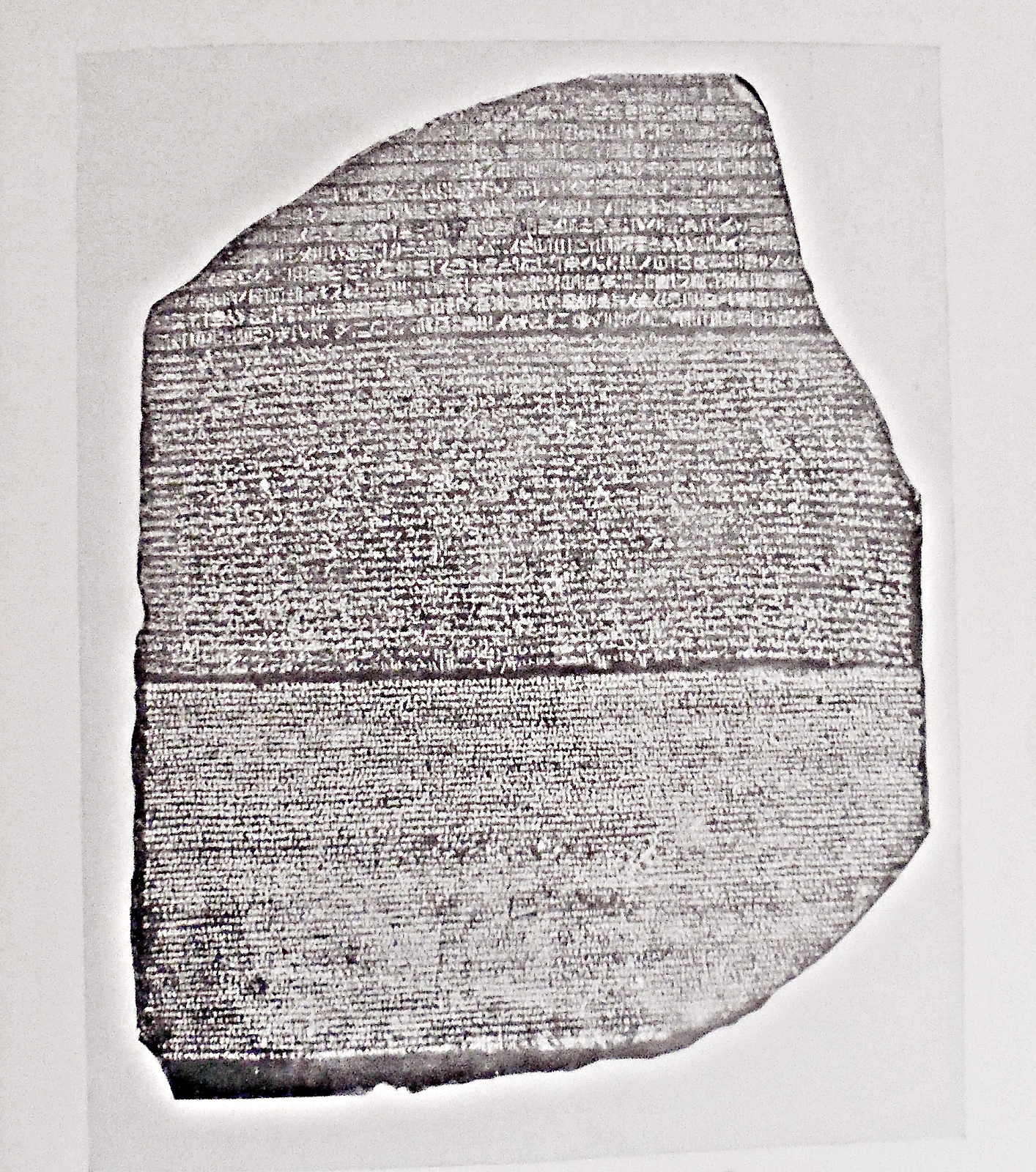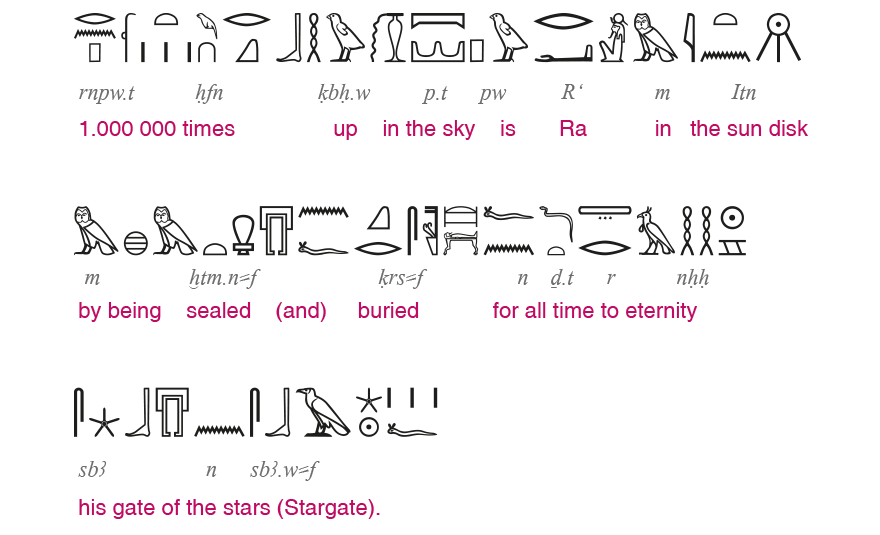Historical Background of Egyptian Hieroglyphs
1) In 1799 a Frenchman, attached to Napoleon’s army found the Rosetta Stone near Alexandria in Egypt
2)After the surrender of Egypt to the British forces in 1801, the Rosetta stone, eventually landed in the British Museum.
3)The Rosetta stone, had three identical texts written in three languages. Two of these were in Egyptian, one of these being Hieroglyphs, and the other in Greek.
4) Two men eventually were able to decipher the Egyptian text on the stone by 1822. First Young, an Englishman, was able to decipher the cartouches. These were 7 exact symbols of a Pharaoh's name surrounded by an elliptical circle with a horizontal line at one end, found written on the stone. Later a Frenchman, Champollion, was able to decode the rest of the text, all with the aid of the Greek inscription.
5) An usual aspect of Hieroglyphics is it can be written and read in several directions as in top to bottom or right to left, which is usual.. The key to reading the text really depends on which way the characters are facing. If they face to the right then the text is read from the right.
5) An usual aspect of Hieroglyphics is it can be written and read in several directions as in top to bottom or right to left, which is usual.. The key to reading the text really depends on which way the characters are facing. If they face to the right then the text is read from the right.

Above are examples of Egyptians text representative of the word Ramsses in numerous cartouches..
1) The Circle or the God Ra in the cartouche gives the sound "Rah". Often the circle, representing the sun, will have a dot in the centre.
2) The hanging plant with 3 limbs gives the sound "M" ( from good to eat sound, plant looks very much like the letter "M")
3) The double staffs or sticks, gives the sound "S,S"
4) The hanging plant and the staff together, gives the sound, "MEES"
The next part of the cartouche (phonic sounds) containing the Feather vowel (E), sign of water (N) and the Senet board (Mon) are translated as Amun. The final symbol translates as "mery" or beloved of Amun.
The Cartouche would read; Ramsses beloved of Amun
The proper way to pronounce Ramsses, Is not RAM-first syllable, SES 2nd syllable. There is no RAM syllable in ancient Egyptian. Ra is the Sun God not Ram. The correct syllables and pronunciation is RAH- MSES. (Ra- me- ss) Similar to the word David. David is a Hebrew name and is pronounced. DAH-VEED. The English pronunciation is DA-VID, which is incorrect.
In this case of the Egyptians, the object was the Shen, the Symbol that represented eternity, which in the figure above is holding in his claws. The Shen is made up of a rope and staff, that is also depicted in an elongated form, known as a cartouche. In the cartouche, the rope is extended to surround a King's name. Hence Shen can also mean, "to encircle". Both the Omega and the Shen are quite similar in appearance, and had similar meaning to these ancient people. The ankh symbol seen beside the Shen symbol also helps to understand the meaning of Shen. Ankh means to extend life or to renew life.
The ancient people of Israel also had their God that held a shen;
The proper way to pronounce Ramsses, Is not RAM-first syllable, SES 2nd syllable. There is no RAM syllable in ancient Egyptian. Ra is the Sun God not Ram. The correct syllables and pronunciation is RAH- MSES. (Ra- me- ss) Similar to the word David. David is a Hebrew name and is pronounced. DAH-VEED. The English pronunciation is DA-VID, which is incorrect.
The Egyptians also had representation of the cartouche that included an Omega like object (symbol) that connects man to the chariots of the Gods. This artistic representation of an eagle, that the Egyptians used in this figure below can be deciphered as;
Ra the Sun God will give life
Note what is held in it's claws, and it's shape along with the Ra symbol above the eagles head.
The ancient people of Israel also had their God that held a shen;
Ezekiel in his vision for the rebuilding of the 2nd temple, (Ezekiel 40 2-4); he was approached by YHWH caring a Shen. "In a Godly vision,...approached by a man who had the appearance of bronze and who held in his hand a flaxen string and a measuring rod."
The Shen throughout the ancient peoples on various religions and ethnic groups all seemed to have a symbol, Shen, Cartouche, or the Omega that represented life.
5)With the fall of Egypt's power, Egypt became more isolated. It's religion and it's Hieroglyphic texts became more obscure. There may have been a time when foreign scholars, Roman and Greek, could read Egyptian text, but this is unknown. By the 1st Century A.D., Hieroglyphs certainly was falling into disuse.
The movie Star Gate and the Ancient text had a number of translations
My translation
1st line 1,000,000 years this sacred water into the sky (heaven) and earth Ra as Sun God
2nd line by his sealed gate for burial for all times to eternity
3rd line his star gate of the stars
Line 1 1,000,000 times needs to be 1,000,000 years. Kbhw translates to the water jar for sacred ceremonies not the word sky which is the symbol indicated next to the the water jar. The symbol below the sky symbol is similar to the jar symbol which is not even translated, would mean earth. The last 5 symbols would read. The owl would translate the word "as" and "etn" would translate as "Sun". The sun symbol has rays pointing down to indicate it's the real sun and not Re the son of the Sun.
Line 2 The snake symbol indicates "his" sealed gate and the symbol for water (wavy line) means "for" burial not past tense buried
Line 3 The first 3 symbols read as star and the next symbol reads as gate so it reads His star gate of the stars plural
Explanations of terms,
1) Sacred water. Ancient texts have written and described by reliefs in stone {Stele} that the ABZU created sacred water that was carried from the tree of life in what is referred to as "hand bags"
This water extends or renews life.
2) Sealed gate is buried for eternity. The ancient world of mankind was ruled over by the watchers and their offspring the giants. A long and bitter war emerged with man breaking the rule of the "gods".
To sustain this end of wars the bridge [Gate] between man and Gods needed to be sealed and buried for eternity.
3) Where does this Gate exist?
Egypt




No comments:
Post a Comment
Note: only a member of this blog may post a comment.